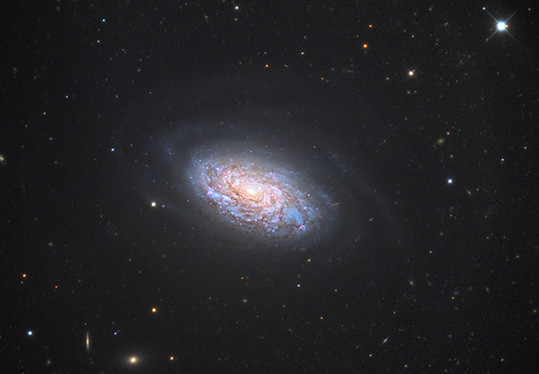

NGC 4414 is an understated spiral galaxy situated approximately 60 million light-years from Earth in the constellation of Coma Berenices. Astronomers have known about its existence since the 1990’s (at the latest), but it is scarcely photographed. In fact, until recently, little was known about the core mechanism powering star formation within the galaxy’s confines. That ended when a research team published a paper in arxiv back in 2014, positing that NGC 4414 is surrounded by an extensive shell, believed to be tied to an interaction with a dwarf galaxy.
This, in and of itself, isn’t unusual. Many galaxies have halo-like shells (our own galaxy does). However, in the case of NGC 4414, its shell extends well beyond the boundary of Hubble’s field of view, making it incredibly difficult to capture it in its entirety, Moreover, the shell is much too faint to be seen with optical imaging tools, ergo, no image caught a glimpse of it, until now.
In a new image from Adam Block (from the Mount Lemmon SkyCenter), the shell can be seen for the first time in color, thanks to a 27-hour exposure time.
Block discusses the significance of the galaxy, and the importance of these features:
We live in a Universe in which we see only highlights. Most of the matter of this Universe is cold, dark, and clumpy stuff that neither absorbs nor emits light. Its existence is inferred from gravitational influence by how it, like the stuff we are made of, warps space-time. Clumpy is the key. According to computer models that astronomers create, dark matter fragmented the early Universe and promoted the formation of small (dwarf) galaxies. Larger galaxies, like our own, were built from the accretion and collision of smaller ones.
If true we expect to see many more dwarf galaxies today than we do. Some astronomers, such as Dr. David Martinez-Delgado (ARI), investigate why we do not see as many as predicted today. It could be that dwarf galaxies were assimilated into larger galaxies at greater rates in the past or perhaps they are still around but difficult to see. So Dr. Martinez-Delgado and his team look at spiral galaxies in search of dwarf galaxies that may now be falling into larger ones. As they fall they leave trails of stars that loop around large galaxies. As the stars orbit about they may eventually spread out to form even more diffuse shell-like structures.
These star streams can support explanatory theories that include cold, dark matter which ties in to the evolution of our Universe. The accretion of dwarf galaxies may also trigger higher than expected star formation within the disks of large galaxies.
[Reference: Adam Block Photos]
Block has also provided an enhanced image that shows the true size of the structure, which you can see here. A larger version of the image up top can be found here.